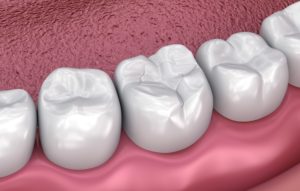The Difference Between Dental Crowns and Fillings
March 6, 2023
 Your teeth are protected by the hardest substance in your body. Your enamel is stronger than bone and some metals, but it isn’t indestructible. Cavities, breaks, and fractures can leave your tooth’s defense system weakened. Whether from tooth decay or trauma, fillings and dental crowns are among the most common restorative procedures. However, which is right for you? Here is what you need to know about the differences between dental crowns and fillings.
Your teeth are protected by the hardest substance in your body. Your enamel is stronger than bone and some metals, but it isn’t indestructible. Cavities, breaks, and fractures can leave your tooth’s defense system weakened. Whether from tooth decay or trauma, fillings and dental crowns are among the most common restorative procedures. However, which is right for you? Here is what you need to know about the differences between dental crowns and fillings.
What is a Filling?
A dental filling is a tried and proven solution to treat tooth decay. Traditional fillings are made of a variety of metals, including mercury. Although effective, there are concerns about the long-term risks of mercury exposure. Not to mention, they stick out like a sore thumb.
As an alternative to metal fillings, composite resin can be used to treat decay. It is shaded to match the color of your enamel to blend in with the tooth structure. You can restore your tooth’s health without compromising its appearance.
While they don’t contain any metals, tooth-colored fillings are strong and durable. They provide a long-term solution to save a tooth damaged by decay using a minimally invasive procedure. A filling can last for about 10 years before needing to be replaced.
What is a Dental Crown?
A dental crown differs from a filling because it covers the entire surface of a tooth above the gum line. Traditional crowns are also made of metals; however, modern restorations are made of porcelain. This provides a natural-looking solution that’s also biocompatible.
Dental crowns can be used to treat large areas of decay when a filling will not be sufficient. They can also treat breaks and fractures. It’s not uncommon for crowns to be used along with other procedures, like after root canal therapy or to hold a bridge in place.
No matter the reason, a crown provides a long-lasting solution to improve the health, function, and appearance of a tooth. On average, a crown will last for 10-15 years before needing to be replaced, but it’s not unusual for them to thrive for much longer with the correct care.
Which is Right for You?
Both methods have restorative benefits, but only a trained dental professional can determine which is right for you. They’ll examine your mouth and learn more about your concerns before creating a personalized treatment plan. They’ll explain whether a crown or filling is needed and what you can expect on the road ahead.
Rest assured, your results will look natural, so you don’t have to worry about a dark spot blemishing your smile.
About Dr. Purvesh Malaviya
Dr. Malaviya earned his dental degree at Boston University and has regularly continued his education to offer specialty services, like Invisalign and dental implants. He is a proud member of many professional organizations, including the American Dental Association and the Academy of General Dentistry. Request an appointment through our website or call (508) 503-6995.
No Comments
No comments yet.
RSS feed for comments on this post.
Sorry, the comment form is closed at this time.



